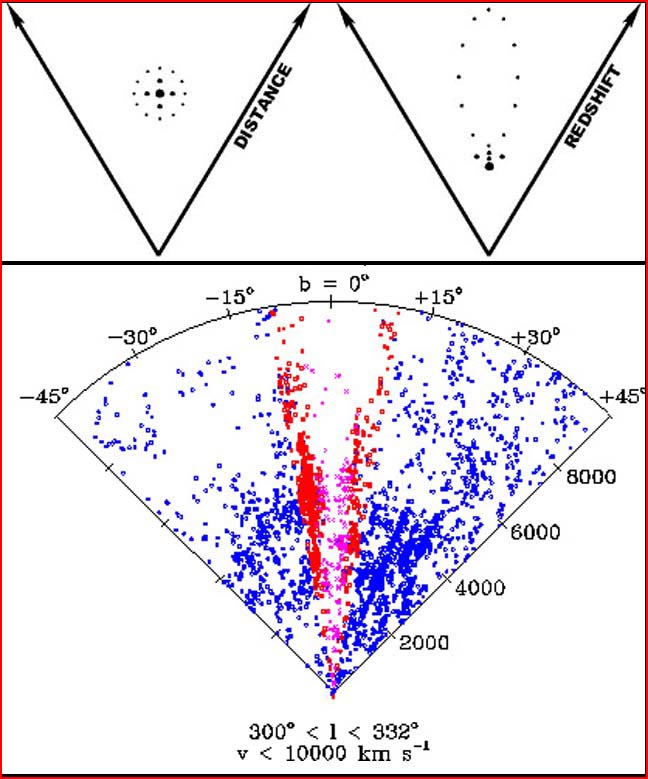In further commemoration of Halton Christian “Chip” Arp, Chip pointed out many star clusters are aligned in such a way that they point toward us. So severe has been the unease over this that some have called the phenomenon “The Fingers of God”. 😯 Quoting Chip’s website:
What do they think this cluster is? In fact they are forced to say it is a structure that I would compare to a great sausage stretching out from us toward the outer reaches of the Universe. The miraculous aspect is that this sausage is pointing directly at us, the observer.
But perhaps an even stranger aspect is that the far end would be receding from us at an appreciable fraction of the speed of light. Quick, the mustard!
These cluster elongations toward the observer have been noticed in other regions of the sky and, causing some inquietude, been dubbed “Fingers of God”. The reason for unease is obvious. The fingers are pointing to the conclusion that we live in some special place in the Universe. Very anti-Copernican.
The Fingers of God puts cosmologists in a difficult position. If we accept the Big Bang as true, then why does it look like we are in a privileged position, that we are special in God’s sight. 😉 If we accept a naturalistic explanation for the Fingers of God, the naturalistic explanation could well over-turn the Big Bang (much to the delight of YECs and some ID-haters, strange bedfellows indeed!). I don’t think anyone knows, we only have guesses.
As a card-carrying YEC, I’m inclined to give strong weight to a naturalistic explanation. Why? See this explanation at the Thunderbolts website. It explains the diagram below, which if true would also overturn the Big Bang:

The big bang theory predetermines the size, the shape and the age of the universe (according to the latest satellite data, it is an expanding sphere 78 billion light years in diameter and 13.7 billion years old.) Because astronomers believe that redshift is a measure of distance, most of the distances of millions of galaxies, quasars, and gamma ray bursts have been distorted. A different interpretation of redshift will imply a much different universe. Halton Arp’s research shows that redshift cannot be a measure of distance. The charts above compare a galaxy cluster in Arp’s observed universe to the big bang’s theoretical universe.
These three diagrams are called “pie charts” because of their resemblance to slices of pie. Our position (the Earth) is at the bottom point in all cases. Distance (away from the Earth) is measured along the straight edges. In the top left image, we show what a galaxy cluster in Arp’s universe would look like without the big bang perspective. It is a family of galaxies and quasars and gaseous clouds of mixed redshifts (in the top diagrams, the large dots are low- redshift, the medium-sized dots are medium-redshift, and the small dots are high redshift). At the center, there is a dominant galaxy — it’s usually the largest galaxy, and the galaxy with the lowest redshift of the cluster. This galaxy is surrounded by low-to-medium redshift galaxies, and toward the edges of the cluster we find the highest redshift galaxies, HII regions, BL Lac objects and quasars.
The image to the right shows what happens if we try to force the same galaxy cluster into a redshift-equals-distance relationship. The cluster becomes distorted. What was once a sphere becomes an elongated bubble. The central dominant galaxy drops to the front of this bubble, followed by a spike of low-to-medium redshift galaxies stretching away from the earth and “bubble and void” of high redshift objects.
Every cluster in the sky does this, like fingers of god pointed at the earth from every direction. The third image is a 90 degree slice of the sky showing all galaxies arranged according to their redshift- determined distances. The Fingers of God distortions show clearly, each representing a single galaxy cluster. (The bubbles and voids are not as clear, because this chart cuts off before it gets to high redshift.) Everything points at the Earth.
Without the redshift-equals-distance distortion, a new picture of galaxy clusters and the universe itself is revealed. The age of the universe is no longer known, because we no longer have a constant expansion to backtrack to a bang. The size is also unknown. Most quasars and some galaxies that we see are closer than we thought they were, because they have been distorted by the Fingers of God. But we have no idea how far the universe stretches beyond our telescopes’ limits. We have moved from what has been called “the end of science”, where everything has basically been discovered, to “the beginning of a new universe” where almost everything is unexplored territory. What an exciting prospect for science in the 21st century.
NOTES
1. The “cocktail” designation indicates speculative ideas, but sufficiently well-supported to merit consideration. Cocktails are appropriate for New Year’s celebrations. I offer a toast to all those part of the UD family.
2. HT Querius